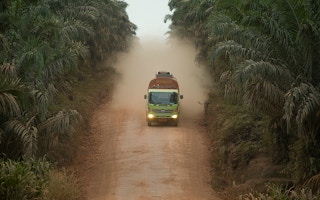Borneo, home to animals like orangutans, rhinos, elephants, and proboscis monkeys is also host to some of the fastest plantation expansion in the world. Now, a new study published on 9 September in Nature’s open access journal Scientific Reports examines how much of this expansion has been happening at the expense of primary forest. It finds that plantations in Indonesian Borneo have historically driven less deforestation than researchers expected – but this seems to be changing.
Borneo is the planet’s third-largest island, demarcated by three countries: Indonesia, Malaysia, and – occupying a tiny corner of the Malaysian side – Brunei. Its relative geographical isolation has led to the evolution of unique species, with 44 of its more-than 200 known mammals endemic to the island, meaning they’re found nowhere else in the world. Along with Sumatra, Borneo is the only place on Earth where elephants, orangutans, and rhinos coexist. Its mountainous rainforest comprises at least 15,000 plant species, of which 6,000 are endemic.
But the rich biodiversity of Borneo’s forests is under increasing pressure from industrial agriculture and other human activities. Commodity crops like eucalyptus and oil palm plantations are competing with native forest for land, with plantations often winning out as global demand for wood pulp and palm oil climbs.
While the palm oil industry is spreading across the globe to new frontiers in South America and Africa, Indonesia and Malaysia are still its primary producers, yielding an estimated 85 per cent of the world’s supply in 2013. Palm oil is an ingredient in a multitude of products, from cookies and toothpaste to lipstick and conditioner.
The demand for palm oil (along with wood pulp and timber) has contributed to significant land cover changes in Southeast Asia. In 2012, Indonesia surpassed Brazil as the world’s biggest deforester, with the country losing 1.4 per cent (2.3 million hectares) of its tree cover – an area nearly the size of the U.S. state of West Virginia – in one year. In 2013, Malaysia took over the infamous title, losing more than 2 per cent of its tree cover that year.
“Borneo is one of the oldest and most important forest ecosystems left on our planet,” said Gemma Tillack, Agribusiness Campaign Director at Rainforest Action Network. “It is a global tragedy that over the past four decades, its biodiverse rainforests have been razed to the ground to make way for millions of hectares of industrial plantations.”
But while scientists and conservationists agree that industrial agriculture has been heavily affecting Borneo’s forests, there hasn’t been a concerted look at the impacts of plantation agriculture on Borneo alone.
To confront this, researchers from institutions and organisations in Indonesia, Malaysia, and other countries analysed satellite data on tree cover change, comparing them to historical forest and concession maps to figure out just how much Borneo’s plantations – oil palm in particular – have displaced native forest.
“
It is a global tragedy that over the past four decades, its biodiverse rainforests have been razed to the ground to make way for millions of hectares of industrial plantations.
Gemma Tillack, agribusiness campaign director, Rainforest Action Network
Some surprising results
They found that between 1973 and 2015, around 18.7 million hectares of Borneo’s old growth forests were cleared. To put this in perspective, the nation of South Korea is about 10 million hectares in size. Of this forest clearing, 7 million hectares had been converted to plantations by 2015.
However, their study indicates only around 4.5 to 4.8 million hectares of this now-plantation land were converted within five years of forest clearing. This five-year mark is crucial, they write, as plantations are likely to be developed quickly after deforestation and thus can be used as a way to figure out if forest was cleared to establish plantations or if the plantations were established on land that had already been cleared for another purpose.
“We were surprised that such a high proportion of the plantation planting in Indonesian Borneo was on land that had lost its forest long-before (more than a decade before),” said study coauthor Douglas Sheil of the Norwegian University of Life Science. “Indeed, we have been saying for some time that plantations should be put where they don’t cause harm — i.e., on land without high conservation values and where local people support the planting – so yes we were surprised at how much planting has avoided replacing forests (we don’t know about local people’s support from this study).
“It seems that indeed much of the area planted was cleared back in the 1970s before oil palm was a major land use in the region.”
But Malaysia is a different story. While the researchers found around 15 to 16 per cent of forest was directly lost to plantation expansion on the Indonesia side of Borneo, on the Malaysian side that number was 57 to 60 per cent.
“The pattern in Malaysian Borneo (Sarawak and Sabah) was less surprising as we see quite a rapid and systematic replacement of old-growth forest with plantations,” Sheil told Mongabay.
This story was published with permission from Mongabay. Read the full story.










